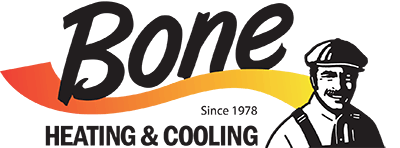
If you are creating or refreshing the landscaping on your Festus, MO property, the choices you make can directly influence your heating and cooling system’s efficiency. Bone Heating & Cooling can provide expert knowledge regarding how the types of foliage you plant and where they’re located can impact your HVAC system and energy consumption.
Plants Impact Airflow
If you have flowers, vines, weeds, or even trees growing around your HVAC system’s outdoor unit, they could be blocking airflow. HVAC systems need sufficient airflow to do their job efficiently. Any interference with this process can force your system to work harder to keep you cool or warm. This leads to increased energy consumption and potential wear and tear on interior components.
The condenser needs adequate airflow to dissipate or absorb heat by way of its coils. If it’s struggling to expel heat, it may overheat, potentially causing damage to the coils. That, combined with increased pressure within the unit, could cause refrigerant leaks in pipes or connections.
Without enough refrigerant in the system, air conditioning units and heat pumps might stop working. Refrigerant is the crucial component of this setup that is responsible for absorbing and releasing heat into the indoor air until it reaches your desired temperature.
Trees Can Damage the System
Strong winds and storms can cause tree branches to break and fall on your HVAC system, damaging fan blades, coils, or casings. Dented or bent blades can scrape against other internal components, further impairing the condenser’s function. Bent blades won’t circulate sufficient air to dissipate or absorb heat.
Besides branches, trees also shed leaves, twigs, and pollen, which can accumulate on and around your outdoor unit. This debris can obstruct airflow, making it harder for your HVAC system to operate efficiently. It can also strain interior components.
Tree roots also pose a risk. They can grow underneath and around the unit, potentially disrupting its stability or damaging underground refrigerant and electrical lines.
Excessive Exposure to the Sun
If your landscaping or home’s structure allows too much direct sunlight to reach the outdoor unit, you could run into problems. Prolonged exposure to the sun increases the temperature around the unit, forcing it to work harder to dissipate heat and maintain efficient cooling. This strain can lead to higher energy consumption and potential overheating.
Additionally, intense rays from the sun can damage plastic and rubber components. Those materials expand, contract, or crack under extreme temperatures. UV radiation can also weaken seals and insulation and degrade electrical components.
Strong Winds Can Interfere With Unit Operation
Exposed outdoor HVAC equipment is vulnerable to the effects of strong winds. High winds can carry dust and other debris to your unit and clog the condenser coils and fans. Strong gusts can also loosen or damage components or interfere with the spinning of the fan blades. Again, your system may need to work harder and use a lot of energy to maintain comfortable indoor temperatures. It may also need costly repairs to fix the damage incurred.
Strategic Landscaping to Optimize AC Efficiency
A well-designed landscape will not only reduce your heating and cooling costs but also protect your HVAC system. There are strategies to consider that can improve your unit’s function.
Trimming Back Weeds and Plants
Always ensure your outdoor unit has at least two to three feet of clearance on all sides, including the top. Regularly trim shrubs, plants, and tree branches to prevent them from obstructing airflow to the condenser unit.
Channeling the Breeze
You can block strong winds by putting high hedges near the perimeter of your HVAC unit. The best varieties include boxwoods and arborvitaes. Other options include trellises or solid fences made with spaced boards to allow airflow. Keep in mind that even these items must be at least two to three feet away from the outdoor unit.
Strategic Shading
You can install an awning or pergola a few feet over your outdoor unit to block the rays from the sun and other harsh weather conditions. Completely enclosing the outdoor unit can trap heat and humidity, creating an environment conducive to mold growth and corrosion.
Proper Ground Cover
Instead of having grass or leaving the ground bare, consider placing pavers or gravel around the outdoor unit to minimize dirt and dust buildup. Grass clippings, soil, and dried debris can easily be picked up by the wind and deposited on the condenser.
Our Experts Can Help
Preserve your HVAC efficiency by consulting Bone Heating & Cooling before customizing your landscape. Our NATE-certified and highly experienced experts will advise you on the best strategies for optimizing your system’s performance. We can also offer repair and AC maintenance services to keep your system in top condition year-round. Ask us about about maintenance agreement! Call Bone Heating & Cooling for guidance on protecting your HVAC unit’s efficiency in Festus.

